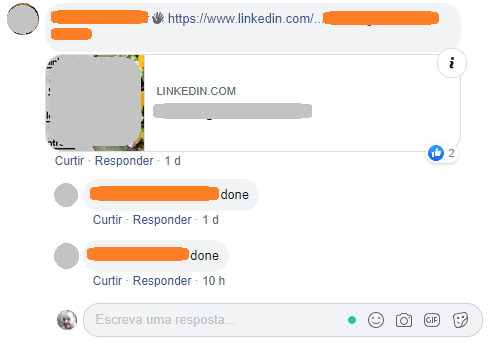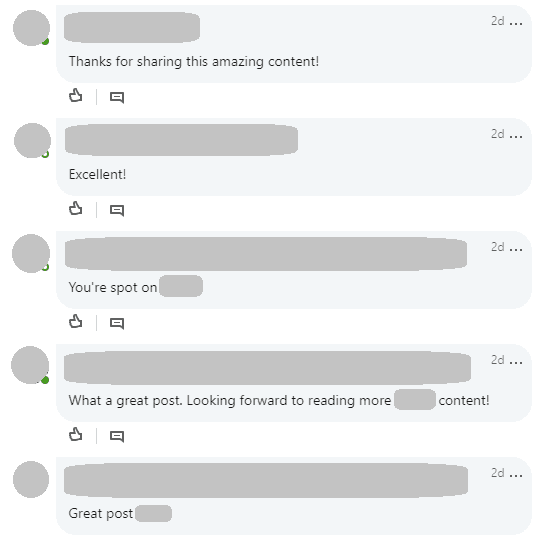How to make the most of your strategy with Linkedin pods
You may know the following feeling: “I researched, dedicated myself, and managed to create a good article! Okay, publish!” And then:
Is the content not good? Maybe the way I wrote it? What do I need to do for it to take off? LinkedIn engagement pods can be great tools for the initial boost that your content needs.
Don’t know what LinkedIn engagement pods are? See our video tutorial by clicking here!
In this article, we will show you the main challenges of the pod strategy and what you can do to improve your reach. The text is divided into sections. You can go through the sequence or go directly to the topic of interest. Ready to get into it?
- Nice content
- Finding (and nurturing) good pods
- Relevant comments (forget the “great post!”)
- Proper use and safety
1 - Content is king, and will always be
Okay, we all know that. But the point here is: there is no silver bullet where you press a button and that’s it! A million views, business, fame, and wealth. If they’re promising you that elsewhere, ok. However, you must be very wary of this.
We value good content. Content that is well built and enjoyable to read, that knows how to explore different media resources and which achieves the proposed objective.
But what happens sometimes is that a lot of good content cannot be “consumed” by a reasonable sample of people. For several reasons, even though it is of good quality, this content is only the first barrier of dissemination (be it for the timing of publication, algorithm, etc.).
Like a catapult, with LinkBoost you can give the initial boost to that content you believe in. So you guarantee more visibility at the key moment after posting and a higher probability of engagement.
But it will always be the content itself that will tell you how much you can keep flying.
2 - Finding good pods
Okay, I have a relevant, quality post and I want to give it an initial boost. But where?
There are numerous options for engagement pods. The main categories that define it are:
- Pod subject
- Channel
- Community
Pod Subject
We believe that the adherence of published content to the subject proposed in each pod is fundamental to a long-term successful strategy.
If you are a member of a pod with 30 participants whose theme is Human Resources, it would not be convenient for someone posting about Bitcoin. But it is very difficult to control the content at all times.
For this reason, LinkBoost has tools to control group quality:
Join Request: Admins can accept or reject the entry of a new member (the admin can evaluate through the LinkedIn profile if that person is somehow related to the proposed pod subject).
Ban Users: Admins can also ban a user who is going against the rules established by the group (e.g.: posting on another topic or in another language).
Report: To assist the admins, any member can report any rules violated by another pod participant, making it easier for the admin to manage and maintain a good quality pod.
The appropriate use and adherence to the subject will always depend on the group itself, however, some features make the work easier.
Another important feature: if you don’t have an invitation to a specific pod, you can find several groups on our Marketplace. Just enter your interests in the search field and you’re done. You can ask to join whatever group you want.
Channel
Pods can also vary according to the channel: manual or automated (like LinkBoost).
Manual: They are closed groups that can be made in different channels. For example, a group on Facebook, WhatsApp, and Slack. They can also be created for a specific niche, like growth marketing or machine learning.
In these groups, each one sends the link to their post and the participants must interact (like and comment) with each other.
Some groups have good discipline and commitment. Still, a lot of time is spent on this dynamic. Imagine yourself with 1, 3, 30(!) likes and comments to do repeatedly, just to comply with the pod rules. What if in your turn, you only had 3 or 4 interactions? Also, you have to remind others to interact again and again. It is sometimes a stressful and time-consuming job.
Automated: To simplify this dynamic there are tools such as LinkBoost, which automate these interactions. You enter the app, ask to participate in a pod with a topic of your interest and that’s it! Interactions are made automatically between all participants.
This way, you can save a lot of time and the interactions are done in a balanced way between the group.
Community
A good way to improve group performance is to connect with participants. Posts with 1st-degree interaction show “cleaner” signs of engagement, contributing to the quality of reach.
On LinkBoost, you can easily see the group members and directly access the profiles on LinkedIn, just by clicking on the name of each one.
Taking care of the subject, the balance between posts, and the connection between members, you will be in a good engagement pod. LinkBoost has several resources that can help you with this task.
3 - Relevant comments
The comment in the post is an important sign of engagement. However, a consequence of some pods is that the vast majority of comments end up being superficial/generic.
That kind of comment is not all bad. They are relatively common in normal interactions and can also be useful in your strategy. The secret is to balance them with slightly more elaborate comments.
In the manual pods, the volume of interactions to be fulfilled is great, and to decrease this time, the comments are of the “great post” type, for almost everyone.
In automated pods, however, there is the possibility for the content owner himself to edit the text of the comments he would like to see in his post. This would prolong the idea originated in the content, increasing the quality of the interaction.
Example: I make a publication about a Webinar that I am going to launch. In the comment, I can already schedule an interaction like: “I just signed up!” and a random user will automatically make that comment.
However, most of the time users do not do this and end up using the same default comments as always.
To help participants create more relevant and quality comments, LinkBoost implemented an exclusive feature: the Comments Library!
There, you will find more than 200 suggested comments. They are divided into several categories of posts such as Congratulations/Compliments, Pre-Launch, Content Oriented, Invitations, etc. You select a category related to your post and add “template” comments linked to the theme of your post. You can still edit them to make them even more customized, increasing their relevance without much effort.
It is a place between generic and super specific comments, balancing automation, and quality (this balance is our mantra!).
This feature is exclusive to LinkBoost and the library keeps growing! You can still save your default comments and save time on future posts.
4 - Proper use
The appropriate use of the tool brings security and sustainability to your strategy. This is a major concern for our development team. Below we list some good practices and how we incorporate these rules for balanced use:
- Randomization: It is important to be aware of the pattern of engagement. In manual pods, this is not a problem. However, some tools trigger interactions right after the post is sent. This generates an accumulation of dozens of interactions in the first minute, making the automation pattern clear. With LinkBoost you can choose time intervals for each interaction (between 20 seconds and 3 mins), making the dynamics more natural.
- Posting Limits: Is there a big discussion about what works best: publishing multiple times throughout the week with more “lean” content? Or fewer posts but betting on longer and more elaborate content?
We believe that there is no golden rule if the content is good. Several people have great results with short posts. However, as a standard model, we believe that between 3 and 5 posts per week are a good number.
At LinkBoost, regardless of free or premium plans (for now they are all free in private beta), there will always be a limit on the number of posts. Currently, each user can submit only one publication per day in each pod in which they are subscribed. This limitation protects the entire group from an excessive number of interactions during certain periods.
- Pod Size: The first impression of being in a group with 600 participants can be a good one. But this interaction generally does not translate into sustainable results. The ideal is to connect with your group to the fullest and create balanced strategies, with consistency. At LinkBoost we limit the number of pod members to up to 100 people.
- Consent / Agreement: Much of the security of this dynamic is in the consent of users to participate in it. No data or action is taken without the consent of the participants. At any time, you can adjust your settings to not like or comment automatically, individually on each of the pods. You can also leave a pod at any time. No questions asked.
Summary table and Final thoughts
The idea of engagement pods is great. However, the manual model brings more work and stress than delivers results. Automation tools solve much of that burden. Still, current tools are lacking in balancing relevance appropriate use, and consistency.
Also, these automation tools (as well as LinkBoost) have their revenue models linked to the number of posts or participation in pods. It would be normal for us to encourage users to post more and more, encourage subscription to more and more pods, and invite many people. But we do not believe in the sustainability of this interaction.
We believe in a balance between quality and reach.
Our idea is not to maximize the short-term result and fill the automation feeds. We want to create a support tool that is useful, simple but mainly sustainable. That’s why we’ve created posting limits, moderation tools, and encouraged proper use.
If you believe in your proposal, if you believe in its content, we will be happy to help you get started.
Interested? Take the opportunity to test LinkBoost without spending anything.
We are in full development and we like (a lot of) feedback.
The chat is open on the platform itself.
Usage experiences, requests for new features, questions, everyone is welcome.
Thank you!




